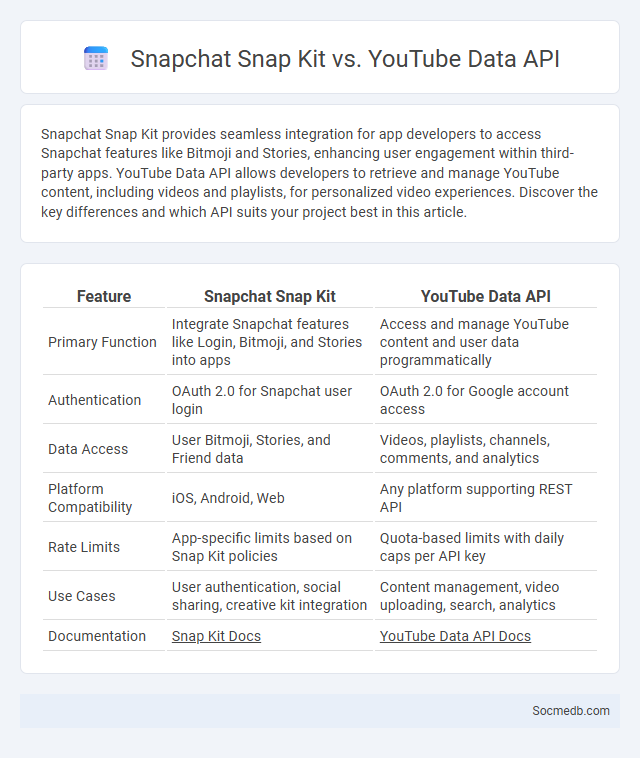
Photo illustration: Snapchat Snap Kit vs Youtube Data API
Snapchat Snap Kit provides seamless integration for app developers to access Snapchat features like Bitmoji and Stories, enhancing user engagement within third-party apps. YouTube Data API allows developers to retrieve and manage YouTube content, including videos and playlists, for personalized video experiences. Discover the key differences and which API suits your project best in this article.
Table of Comparison
| Feature | Snapchat Snap Kit | YouTube Data API |
|---|---|---|
| Primary Function | Integrate Snapchat features like Login, Bitmoji, and Stories into apps | Access and manage YouTube content and user data programmatically |
| Authentication | OAuth 2.0 for Snapchat user login | OAuth 2.0 for Google account access |
| Data Access | User Bitmoji, Stories, and Friend data | Videos, playlists, channels, comments, and analytics |
| Platform Compatibility | iOS, Android, Web | Any platform supporting REST API |
| Rate Limits | App-specific limits based on Snap Kit policies | Quota-based limits with daily caps per API key |
| Use Cases | User authentication, social sharing, creative kit integration | Content management, video uploading, search, analytics |
| Documentation | Snap Kit Docs | YouTube Data API Docs |
Introduction to Social Media APIs
Social Media APIs enable seamless integration and interaction with popular platforms like Facebook, Twitter, and Instagram, allowing you to access user data, post content, and analyze engagement in real time. These interfaces provide structured endpoints for developers to automate processes, retrieve analytics, and enhance user experiences across digital ecosystems. Understanding Social Media APIs empowers your applications to leverage social networking features while maintaining compliance with platform-specific guidelines.
Overview of Snapchat Snap Kit
Snapchat Snap Kit is a comprehensive developer platform that enables seamless integration of Snapchat's features into your apps, enhancing user engagement through Bitmoji avatars, Stories, and login authentication. By leveraging Snap Kit's capabilities such as Creative Kit, Login Kit, and Bitmoji Kit, your app can access millions of Snapchat users, fostering personalized and interactive experiences. This integration not only boosts user retention but also allows for innovative content sharing within the Snapchat ecosystem.
Overview of YouTube Data API
The YouTube Data API enables developers to access and manipulate YouTube content, including videos, playlists, and channels, programmatically. It facilitates searching for videos, retrieving detailed metadata, managing subscriptions, and uploading content, empowering your applications to interact seamlessly with the platform. Using this API optimizes your ability to analyze audience engagement and integrate social media functionalities efficiently within your digital strategy.
Comparing Snap Kit and YouTube Data API: Key Differences
Snap Kit and YouTube Data API offer distinct functionalities tailored to their platforms; Snap Kit primarily enables app developers to integrate Snapchat's features like login, Bitmoji, and Story sharing, enhancing user engagement within third-party apps. In contrast, YouTube Data API provides comprehensive access to YouTube's video content, channels, playlists, and analytics, enabling developers to manage videos, retrieve metadata, and analyze performance metrics. The key difference lies in Snap Kit's focus on social interaction and identity integration versus YouTube Data API's emphasis on video content management and data retrieval.
Authentication and Security Features
Social media platforms employ advanced authentication methods such as two-factor authentication (2FA) and biometric verification to safeguard user accounts against unauthorized access. These security features help protect Your personal data and maintain privacy by requiring multiple layers of identity confirmation. Continuous monitoring and encryption protocols further enhance security, preventing data breaches and cyberattacks on social media accounts.
Data Access and Privacy Considerations
Data access and privacy considerations on social media platforms require careful management of personal information to prevent unauthorized use and protect your digital identity. Platforms employ encryption, consent frameworks, and transparent data policies to regulate how user data is collected, stored, and shared with third parties. Understanding these mechanisms empowers you to control your privacy settings and safeguard sensitive information against potential breaches.
Integration Capabilities and Use Cases
Social media platforms offer robust integration capabilities enabling seamless connectivity with third-party applications, customer relationship management (CRM) systems, and e-commerce solutions to streamline marketing, sales, and customer support. Use cases include targeted advertising campaigns leveraging user data analytics, real-time customer engagement through chatbots, and influencer marketing amplified by social media listening tools. These integrations enhance cross-channel communication, optimize user experience, and drive measurable business growth.
Developer Support & Documentation
Comprehensive developer support and detailed documentation are critical for optimizing social media platform integration and application development. Robust APIs, clear guidelines, and extensive code examples enable developers to create seamless user experiences and innovative features. Continuous updates and responsive technical assistance foster community engagement and accelerate development cycles.
Pros and Cons of Each Platform
Facebook offers extensive user reach and robust advertising tools but faces challenges with privacy concerns and algorithm-driven content that can limit organic visibility. Instagram excels in visual engagement and influencer marketing yet struggles with issues like unrealistic beauty standards and mental health impacts among younger users. Twitter provides real-time updates and public discourse opportunities while dealing with character limits that restrict depth and frequent misinformation spread.
Choosing the Right API for Your Project
Choosing the right social media API for your project requires analyzing platform compatibility, data access limitations, and rate limits to ensure seamless integration and efficient data retrieval. Consider popular APIs like Facebook Graph API, Twitter API, and Instagram Basic Display API, based on the specific functionality needed such as user authentication, content posting, or media analytics. Evaluating documentation quality, community support, and cost factors further optimizes API selection to enhance project development and scalability.
 socmedb.com
socmedb.com